|
|
| |

|
| |
The Downs
close to Epsom have always been one of the green
lungs of the greater London area and even became
something of a health pilgrimage spot with the
discovery of Epsom Salts around the year of
1620. But despite the regular stream of weekend
ramblers from the city, the Downs basically remained
a nice place out in the middle of nowhere. The sole
reason to build a railway line terminus there was
horse racing (which had also started around 1620 and
turned into a major event with crowds of spectators
since the 1770s), and the sole point the
Banstead & Epsom Downs Railway was aiming at was the Epsom
racecourse and Grandstand.
|
| |
Due to fierce opposition of
both the Lord of the Manor of Epsom Downs and
the Epsom Grandstand Association, however,
the original plans to build the station as
close as 220 yards to the Grandstand had to
be changed.
In the
end Epsom Downs station came to be built some
1100 yards away from its actual destination.
While
this was of course much closer to the
racecourse than any other railway station at
the time, Epsom Downs station still remained
slightly "in the middle of nowhere"
- a fact which became all the more evident
when the South Eastern Railway opened its
station at Tattenham Corner in 1901 in the
close vicinity of the racecourse and
Grandstand.
|
|
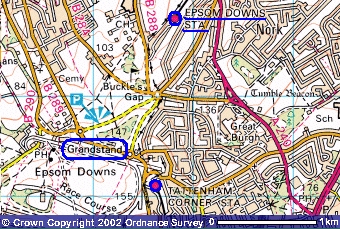 Image reproduced
with kind permission of Ordnance
Survey Image reproduced
with kind permission of Ordnance
Survey
|
|
| |
| However, the area bordering
Epsom Downs station to the East and South began to
see a steadily rising amount of housing development,
providing new and unforeseen commuter traffic to
London as of the 1920s for the branch. |
| |
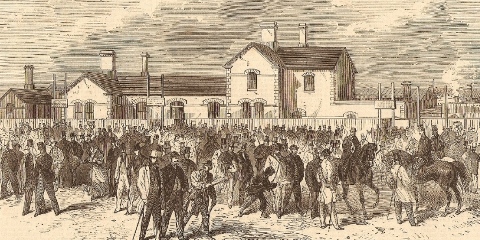
"THE
NEW RAILWAY STATION AT THE
RACE-COURSE, EPSOM DOWNS"
(Illustrated London News
Supplement, 3 June 1865) (personal
collection)
|
|
The
first ever published image of Epsom Downs
station comes
from the Illustrated London News Supplement,
which devoted half a page in its
edition of 3rd June 1865
to feature an illustration of the
terminus building only two weeks
after the branch line had opened to
traffic. Photography
was well established in England by
that time, and it is therefore almost
certain that numerous pictures must
have been taken on and around the
opening of this new branchline, not
the least due to the prestigious clientèle
which were amongst the 70,000 people
who for the first time took a train
to Epsom Downs to see the Derby in
late May 1865.
The oldest photographic picture
showing the railway at Epsom Downs
which is publicly available, however,
seems to be a view taken on 30 May
1877 - Derby Day.
|
|
|
| |
| No less than fifteen locomotives can be spotted
in this picture (which reputedly was also on display
in the stationmaster's office for decades), already
turned and thus ready for the return trips of their
race specials, some of which were all 1st class. |
| |
| Most period photographs
depicting steam on the line on Derby day
feature a glimpse of the Royal Train, but the
1877 view shows no such special locomotive. Although
the first Royal train journey took place as
early as 1842, royalty only started to travel
to the Derby by train on the Epsom Downs
branch from the end of Queen Victoria's reign
(1901) until 1924 (Kirby, 1983).
By 1900, the track
plan at Epsom Downs was characterized by the
numerous facilities required for the
servicing and turning of steam locomotives,
the station approach laid out for the
handling of the multitude of trains it only
ever saw once a year.
|
|
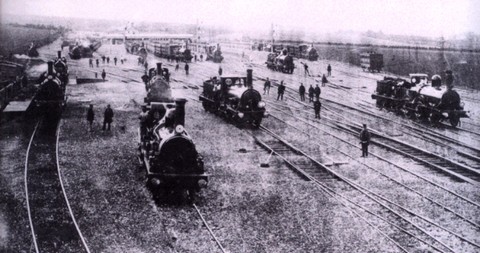
Epsom
Downs on Derby day in 1877 - traffic and
engines galore!
(Lens
of Sutton)
|
|
| |
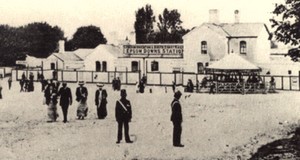

[left]
Epsom
Downs Station, 1900
(Lens
of Sutton)
|
| |
| This track layout was cut
back substantially after electrification came into operation in July 1930,
and the turntable was removed in February 1931
(Kirby, 1983). But even so, Epsom Downs station
remained what it had been right from its
construction: a paradoxical affair. Designed to
handle great bustling masses of travellers, these
only came here on a very limited number of days
during the year. For all the rest of the year, the
station complex was oversized beyond description. |
| |
| Despite
the 1931 modifications in the station throat
area, the nine platform layout was kept right
up until 1969, when all platforms other than
no. 4 and 5 were put out of use and all other
trackwork abandoned and eventually lifted.
But even then the station
echoed a ghostly memory of its glorious past
in the heyday of late 19th and early 20th
century race traffic.
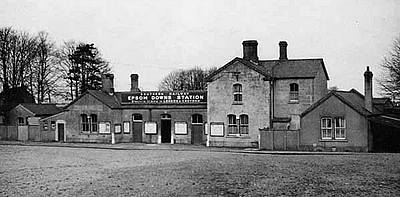
|
|
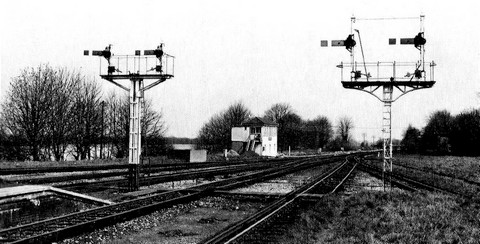
[above]
Semaphore signals still guard the station
throat at Epsom Downs,
but the view dates from the late 1960s
(Lens of Sutton)
[left] Epsom Downs Station in 1959,
already looking slightly gloomy
(D.
Clayton, courtesy of Subterranea
Britannica's Disused Stations website)
|
|
| |
| On 21 December 1969, the
intermediate signal boxes on the branch were
abolished and automatic colour-light signalling
introduced between the terminus and Sutton. Epsom
Downs itself retained most of its semaphore signals
in spite of a by now considerably simplified track
layout. |
| |
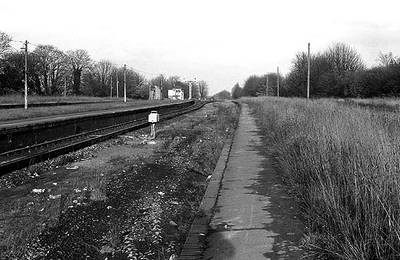
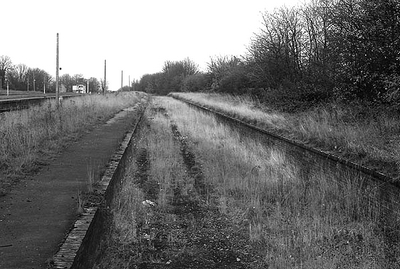
|
|
By
the time the mid-1970s rolled around
the whole station complex - with its lifted
tracks, wide open and unused space
and growing shrubbery - began to take
on an even ghostlier atmosphere than
it already had previously.
What used to be platform 8/9
was now already overgrown with trees
as maintenance and upkeep was
concentrated on the single
double-side platform still in use.
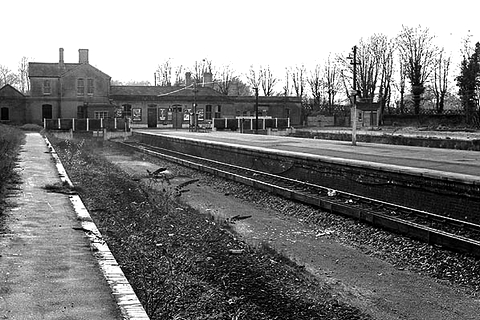
Three
views of the station building and
complex taken in November 1975
standing on former platform 6
(Nick Catford, used with kind
permission, courtesy of
Subterranea
Britannica's Disused Stations website)
|
|
|
| |
| Rather fittingly in tone, Epsom Downs saw
predominant use of 4SUB multiple units - a class of
suburban multiple units (designated Class 405 under
British rail TOPS as of the early 1970s) which was
itself on the way out at that time. Used on
inner-suburban workings in the South London area
since the early 1940s (and continuously built or
converted until 1951), the 4SUBs were beginning to be
withdrawn by British Rail as of 1972. |
| |
| The large numbers built meant
that this withdrawal process would not be
completed until 1983, but the Epsom Downs
branch proved a regular destination for these
EMUs on the retreat.
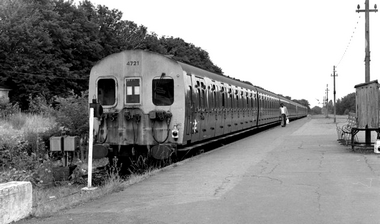
4SUB
4721 in July 1979
(Dr
Neil Clifton, under creative commons licence)
|
|
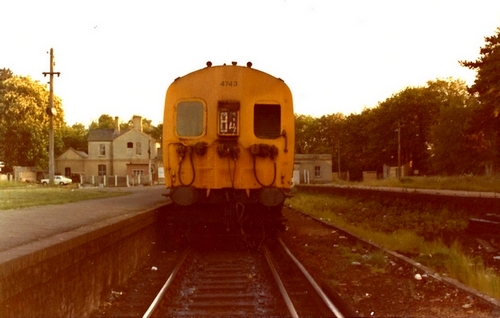
4SUB
4743 in mid-1977
(Alan
Bricker, used with kind permission)
|
|
| |
| Epsom Downs Signalbox,
erected in 1879 by the LBSCR's preferred contractor,
Saxby & Farmer, was a substantially sized
building, measuring about 42 ft in length. In its
later days, the decaying timber was patched up with
asbestos panels. |
| |
| The box
contained two lever frames, a Saxby &
Farmer spindle frame of 50 levers together
with - up until the layout was rationalised -
a 25 lever Saxby & Farmer rocker locking
frame, fitted in 1908 at the same time as the
original frame was relocked (this would have
allowed the two frames to have worked
together even though they were so different).
When the
layout was rationalised the 25 lever section
was replaced with a two lever Stevens Knee
frame just to control the detonator placers.
Strangely the
interlocking in the old frame remained
unchanged until the late 1970s, which gave
rise to a great number of levers worked just
to maintain the original locking moves (these
are the Brown/Blue levers in the pictures
below).
|
|
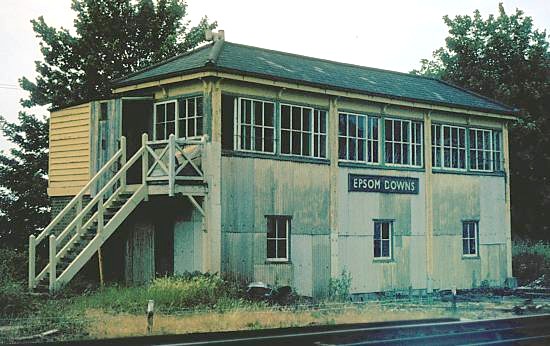
(John
Hinson, used with kind permission, courtesy
of the Signal Box
Website)
|
|
| |
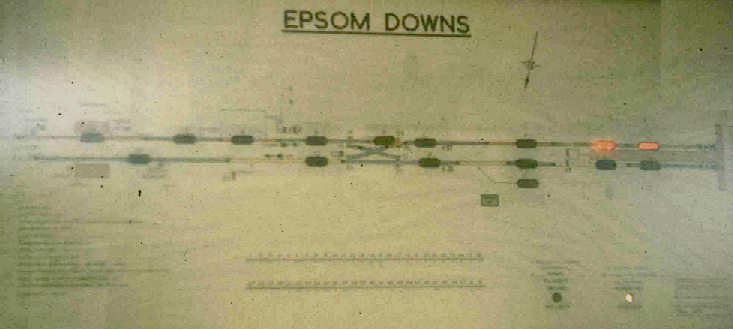
Interior views
from early 1975 show the reduced track diagram
(above) and the levers (below)
(Graham
Floyd, used with kind permission)
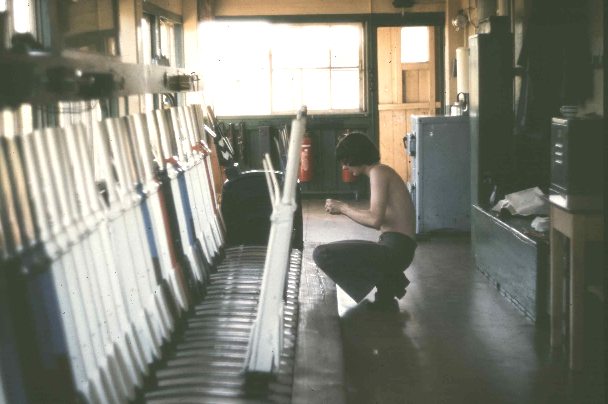
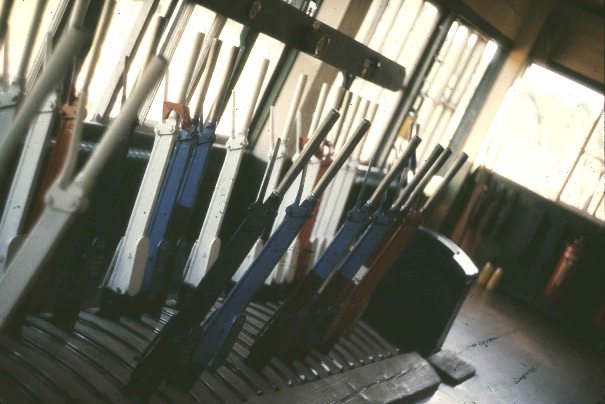
|
| |
| The signal box was
scheduled to close in 1982 in connection with the
resignalling of the area (controlled from a box named
Victoria but actually located at Clapham Junction),
but the end came earlier as the box was destroyed by
a fire on November 16th 1981. |
| |
| With
immediate effect there were no more through
trains on the branch from 26 November 1981
until 4 November 1982, due to pilotman
working being implemented between Sutton and
Epsom Downs as an emergency measure. This
allowed BR to temporarily operate the line as
a single dead-end branch under the "one
engine in steam" rule. This resulted in a shuttle
service between Epsom Downs and Sutton, where
all passengers were required to alight and
change to connecting trains. On some
occasions, this back and forth train service
between Sutton and Epsom Downs was operated
by preserved 4SUB unit 4732, restored to
original green livery and bringing back some
original Southern Electrics atmosphere to the
line.
On 3 October 1982, the inevitable
happened - the singling of the Epsom Downs
branchline beyond a point some 40 yards on
the Belmont side of Ventnor Road bridge,
midway between Sutton and Belmont.
|
|
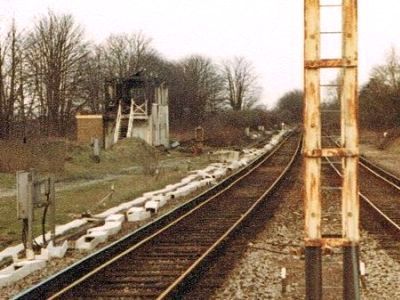
The
semi-destroyed Epsom Downs signal box as seen
from the platform end on 13 March 1982
(NN,
personal collection)
|
|
| |
| The station layout at Epsom
Downs, however, remained unchanged and thus retained
its previous layout with an island platform serving
two tracks as platforms 1 and 2. |
| |
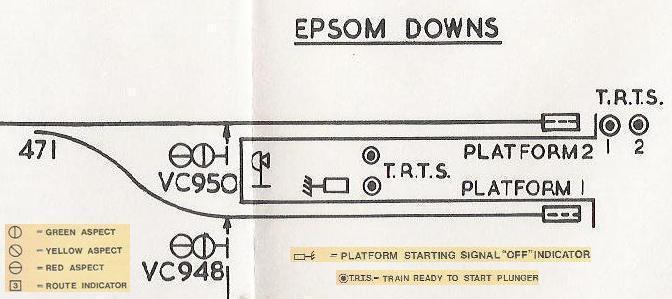 |
|
The
rest of the branch, however, underwent a
radical visual change as the former Up line
was lifted throughout the summer and autumn
of 1982.
Track and signalling
diagram at Epsom Downs as of 3 October 1982
(BR
Signal Instructions, personal collection)
|
|
| |
| With the notable exception
of the 1982 shuttle services, there were no more
4SUBs calling at Epsom Downs, replaced by 4EPB (Class
415) and 2EPB (Class 417) multiple units. |
| |
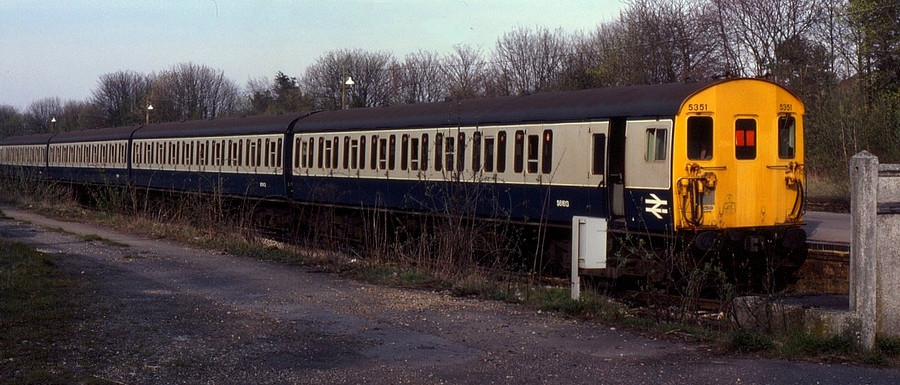
Cl 415 (4EPB)
5351 awaiting departure from platform 1 (formerly
platform 4) on 21 April 1984 - the wide platforms
(originally meant to handle large groups of
passengers on Derby day) by now resembled farm tracks
more than anything else.
(Phil
Richards)
|
| |
A
STATION VANISHES
|
| |
| All traces of the
station's past and the reason for building the branch
in the first place were completely eradicated on
February 15th and 16th 1989 when the old station
building was pulled down. |
| |
| A new station which looked just like
one of the newly built houses in its
neighbourhood was built some 300 yards away
from the original station concourse. With now
just one platform and a single line of track,
virtually nothing remained of what once was
Epsom Downs station - indeed, only the
pillars supporting the valanced canopy were
rescued from the old building and put to
decorative use.

|
|
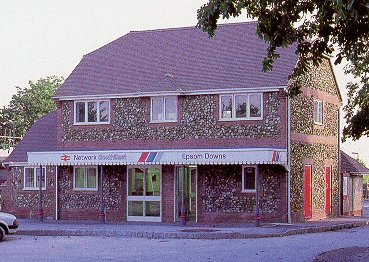
The new
station building shortly after its opening in
1989
|
|
| |
| All that remains today of
the once complex station layout is the track
originally running into platform 4. Because the
single line on the branch is the original Down line,
the track curves slightly to the right after clearing
the new platform. |
| |
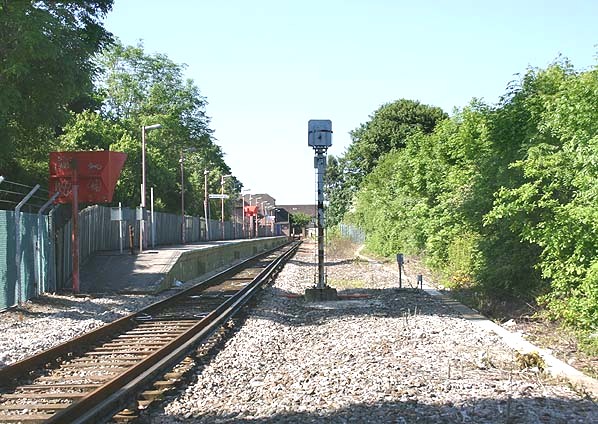
The track
layout of the new Epsom Downs station, seen from the
station throat on 24 May 2004
(Nick
Catford, used with kind permission, courtesy of Subterranea Britannica's
Disused Stations website)
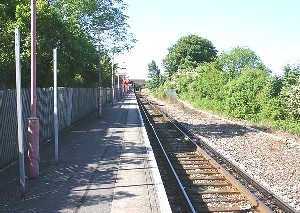
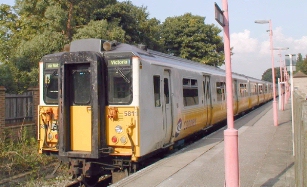

General view of
the platform area (left, May 2004), platform from the
station end (centre, September 2001) and from the end
of the platform (right, March 2002)
(left: Nick
Catford, used with kind permission, courtesy of
Subterranea Britannica's
Disused Stations website / middle & right:
Robert Oakes, used with kind permission)
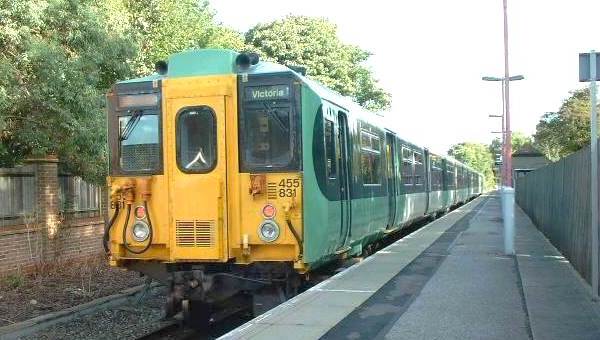
The tail end of refurbished Cl 455 831, departing
Epsom Downs for London Victoria on 1 October 2005
|





















